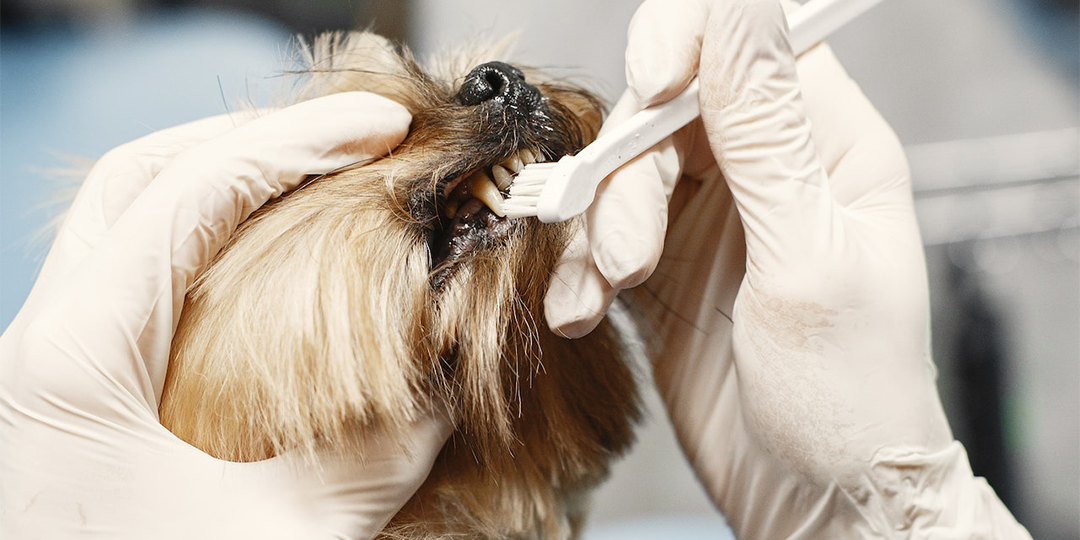
Tips & Tricks to Slow Dental Disease Between Cleanings
As a pet owner, taking your dog or cat to a veterinarian for annual exams that include vaccines, bloodwork, and refills for flea and heartworm medications are part of overall health and wellness. Annual visits and regular check-ups are essential for preventive care and quality of life. But have you not considered that your pet's oral health is also essential preventive care that can impact its health and quality of life? Dental care for your pet requires support from your veterinarian with Professional dental cleanings under anesthesia performed by your veterinarian are crucial, but there are proactive steps you as the pet owner can take with at-home oral care products.
Dental Disease: Why Is Intervention Needed?
Similar to humans, regular preventative dental care visits protect our pets from contracting severe conditions that can lead to serious illness—even death. Dogs and cats have similar dental anatomy to humans, though the shape and number of teeth differ according to their needs. Plaque formation can lead to dental disease. Plaque is made up of bacteria that, in humans, forms after brushing our teeth. When we brush our teeth twice daily, brushing disrupts bacterial growth, slowing the process. In dogs and cats, the bacteria forms soon after a professional cleaning at the veterinarian's office. If brushing is rarely or never performed, the bacteria continue to multiply and change their behavior, progressively becoming more destructive and affecting attachment of the gums and bone that help support the tooth root.
Oral health aims to prevent gingivitis with eventual periodontal disease by maintaining a healthy mouth. Gingivitis presents with red, inflamed gums, but there is still normal attachment of the gums and bone. If gingivitis is not treated, the condition progresses to periodontitis with tell-tale signs of bone loss, gum recession, and bleeding. The professional cleaning and treatment of affected teeth in pets help keep the condition under control. Pets that do not receive regular preventive professional cleanings will commonly lose teeth to extraction. Unlike people, our pets cannot routinely brush their teeth.
Pet Dental Products: What Will Work Best?
Did you know 80% of dogs and cats suffer from some form of gum disease? As a pet parent, you can slow down the progression using products at home after a professional cleaning. Think of it as having a clean slate.
There are many products out there, but which ones are the best for pets? The Veterinary Oral Health Council (VOHC) is a group of boarded veterinary dentists that review trials and research done by product manufacturers. The VOHC approves products based on their ability to reduce plaque bacteria and tartar on the teeth. Visit the VOHC website to see a list of approved products for dogs and cats. Some products can be purchased over the counter, and some are available only at your veterinary clinic. Check with your veterinary clinic to see which products it recommends.
Brushing and Dental Wipes
Brushing your pet’s teeth depends upon your ability to handle your pet. Can you safely and gently open your pet's mouth and inspect the teeth? Brushing of the teeth is the most beneficial as the brushing action and the pet toothpaste disrupt the plaque bacteria. If you are considering brushing, then it must be performed daily in order to be effective. If you are at risk of being bitten or your pet wrestles away from you and avoids you, then direct application of products on the teeth and gums, such as brushing, may not be the best choice. One alternative may be to provide treats before and after to help your pet acclimate to brushing.
Dental wipes are an excellent alternative to brushing, because rubbing the wipe on the teeth and gums can also disrupt plaque bacteria and may be readily accepted, especially in cats. Again, do not attempt these if you are at risk of being bitten and your pet averts you.
Dental Diets and Dental Treats
You must assess your dog or cat's interests in food and treats. Do they have a good appetite? Do they enjoy treats? A common myth about keeping a dog’s teeth clean is to feed the dog only dry food. Studies have shown that moist and dry foods neither increase nor decrease plaque bacteria growth on the tooth surface. There are other dental products if your pet does not accept brushing or dental wipes. A food or treat needs to maintain contact with the tooth surface to provide actual cleansing. Also, if your pet is on a restricted diet, then check with your veterinarian before introducing a new diet.
When giving treats to your dog and cat, make sure you monitor that the treat is being chewed on to get optimum benefits and that your pet does not choke. Food with textural characteristics such as Hills™ T/D maintains prolonged contact on the tooth surface that removes plaque bacteria. Greenies™ dental treats for dogs and cats and Oravet™ chews also work in the same way. Follow label directions to ensure you feed the correct treat size and at the recommended frequency.
Dental diets and some dental treats coated with an enzyme called sodium hexametaphosphate contain calcium chelators. Chelators reduce the amount of calcium found in dental tartar. Some of these enzymes can also provide antibacterial activity. Some treats can be coated with chlorhexidine. Chlorhexidine, an oral antiseptic commonly used in human dentistry at a 0.12% concentration, has decreased the early inflammation of gingivitis if applied consistently over time. Chlorhexidine has a quick onset and lasts seven hours when used as an oral rinse after tooth removal.
Fatty Acids
A product containing 1-tetradecanol complex (1-TDC) formulated for dogs and cats is available as a gel cap. The gel cap's contents are squeezed out along the gums of your dog and cat. 1-TDC has been found in studies to be successful in treating chronic inflammation. The application and taste of this product are well-tolerated in dogs and cats. These products are available online in a dog and cat formulation or through your veterinarian.
Food and Water Additives
Additive products are top-rated because they are easy to integrate into your pet's feeding regimen. Water additives are added to your pet's water bowl and reintroduced when the bowl is cleaned and the water is replaced. Food additives are sprinkled over the pet's food. The food additive that is the most effective is one with the ingredient Ascophyllum nodosum, a brown alga. Consistent use of these products has decreased plaque bacteria and bad breath.
Water additives are found to reduce canine malodor. Additives with the active ingredient RF2 have been shown to adhere to the saliva that covers the teeth and makes it brittle and rinsed out as they drink the annotated water. Another product contains chlorine dioxide, which is an oxidant. Oxidants have excellent antimicrobial action. Lastly, avoid water additives containing Xylitol, because it is toxic to dogs and cats. When introducing water additives, be aware that some pets can smell the product in the water and refuse to drink it. Some pets don't like the taste or smell. If that happens, check the return policy on the product and contact the manufacturer.
Oral Health for Pets is a Team Effort
What decides how often a teeth cleaning is performed depends on your pet's size and oral health. Small-breed patients tend to need cleanings more often than large-breed dogs.
Oral health for your pet is a team effort between you and your veterinarian. Consenting to regular dental cleanings under anesthesia and your home interventions improves your pet's quality of life. The best way to alleviate concerns about your pet's oral care is to talk to your veterinarian. Ask the questions because collaborating with your veterinarian, and getting these questions and concerns answered, will help you make the best decisions for your pet.




